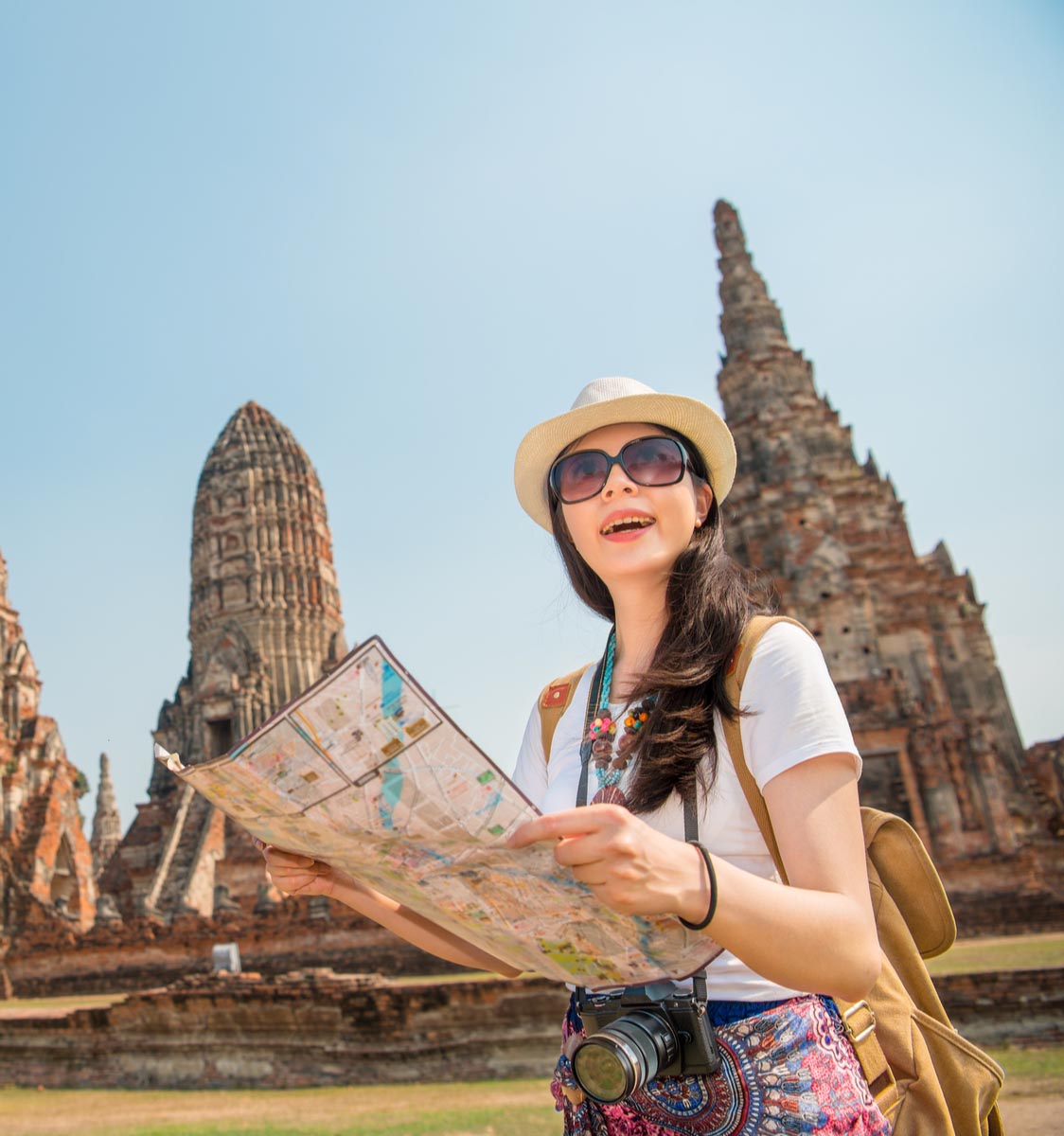The Harmony of Cambodia’s Royal Ballet: Khmer Apsara Dance
With unparalleled beauty and elegance, Cambodian Apsara dancers captivate audiences with their exquisite costumes and mesmerizing hand movements. Originally known as the “Royal ballet”, reserved only for the palace and esteemed guests, this unique dance style has evolved into a globally renowned symbol of Khmer culture. UNESCO also recognized its significance by designating the Royal Ballet of Cambodia as an 'Intangible Cultural Heritage,' highlighting its enduring legacy and cultural importance.
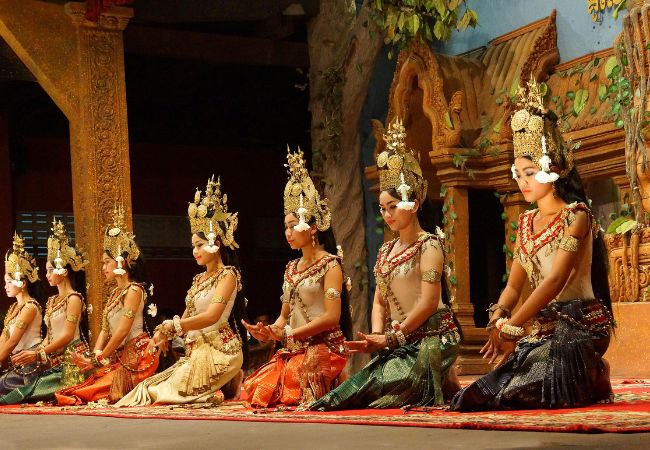
An Apsara dance, also known as "Royal Ballet" performance
I. What is the Apsara Dance
According to ancient stories, Apsara is used to summon the fairies of clouds and water. When the fairies play, sing, and dance, plants and animals grow and flourish. Therefore, Cambodians praised Apsara as the Goddess of Prosperity. It’s easy to find the image of Apsara performances in Cambodian poetry and music works.
The Apsara, meaning 'water nymph' or 'celestial spirit,' holds deep roots in ancient Indian mythology, where these divine beings descended from the heavens to entertain gods and kings with their captivating dance and charm. Their presence is prominent in South and Southeast Asian history, evidenced by ancient Hindu and Buddhist texts and artworks, notably depicted in Angkor Wat.
The Apsara, meaning 'water nymph' or 'celestial spirit,' holds deep roots in ancient Indian mythology, where these divine beings descended from the heavens to entertain gods and kings with their captivating dance and charm. Their presence is prominent in South and Southeast Asian history, evidenced by ancient Hindu and Buddhist texts and artworks, notably depicted in Angkor Wat.
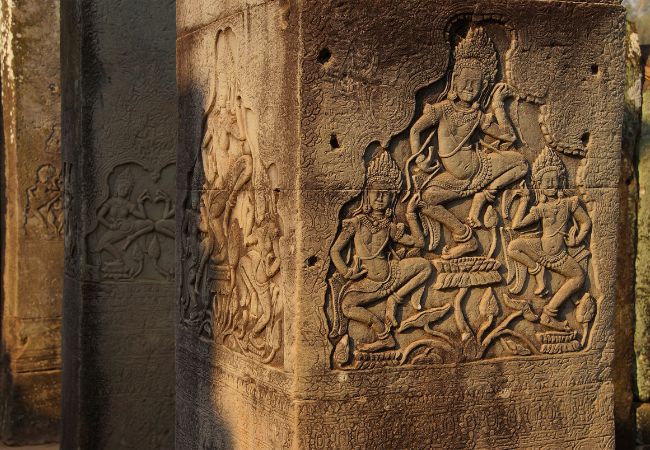
A carving depicting Apsara dance moves at Angkor Wat
The Apsara dancers, classical in form yet full of vitality, enchant audiences with their soft and gentle movements while adorned in opulent attire embellished with gold, silver, and pearls. Through this dance, Cambodians express their aspirations for peace and prosperity, celebrating the beauty of nature and paying homage to their king.
II. The History of Apsara Dance
1. Khmer Apsara Dance from day one
Introduced around the 1st century AD, the Apsara dance became a thriving art form in Cambodia. During the Angkor period, it was exclusively performed for kings on significant holidays or occasions to honor Hindu gods. Therefore, it is also known with the name as the “Royal Ballet” Under the reign of King Jayavarman VII, the recorded number of Apsara dancers reached an astonishing 3,000, surpassing the population of the capital at that time. While initially rooted in Hinduism, the Apsara dance in Cambodia evolved by the 13th century, influenced by the intricate sculptures and carvings found in the ancient Khmer temples.
2. Khmer Apsara Dance thriving
By the 15th century, the Apsara dance had nearly vanished, fading into obscurity with the decline of the Angkor civilization. However, its revival began in the late 1940s, thanks to the efforts of Queen Sisowath Kossamak. During a visit to a local primary school in the 1940s, Queen Sisowath Kossamak was deeply moved by a performance by the children, who imitated the graceful movements of the Apsaras depicted on the walls of Angkor Wat. Inspired to revive this ancient dance form, she championed its resurgence.
Queen Sisowath Kossamak handpicked her granddaughter, Princess Buppha Devi, at the tender age of 5 to embark on a professional dance career. After years of dedicated practice, Princess Buppha Devi became the first modern-era Apsara dancer, spearheading the revival of this cherished tradition.
3. Khmer Apsara Dance under the effect of the Khmer Rouge
Apsara dancing practices were severely affected in the 1970s when the Khmer Rouge regime decimated much of the country’s infrastructure, culture and traditions. Almost 90 percent of Cambodia’s artists and intellectuals were systematically eliminated by the Khmer Rouge, devastating what had been a flourishing artistic community.
Princess Buppha Devi, upon her return from exile, played a pivotal role in resurrecting the traditional Apsara dance from the ashes of the brutal Khmer Rouge rule in the 1970s. Throughout the 1950s and 1960s, Princess Buppha Devi emerged as the face of traditional Khmer dance, both within Cambodia and on the global stage. She tirelessly fought for the revival of this cherished art form throughout her life, ensuring its legacy would endure for future generations to enjoy and cherish.
Princess Buppha Devi, upon her return from exile, played a pivotal role in resurrecting the traditional Apsara dance from the ashes of the brutal Khmer Rouge rule in the 1970s. Throughout the 1950s and 1960s, Princess Buppha Devi emerged as the face of traditional Khmer dance, both within Cambodia and on the global stage. She tirelessly fought for the revival of this cherished art form throughout her life, ensuring its legacy would endure for future generations to enjoy and cherish.
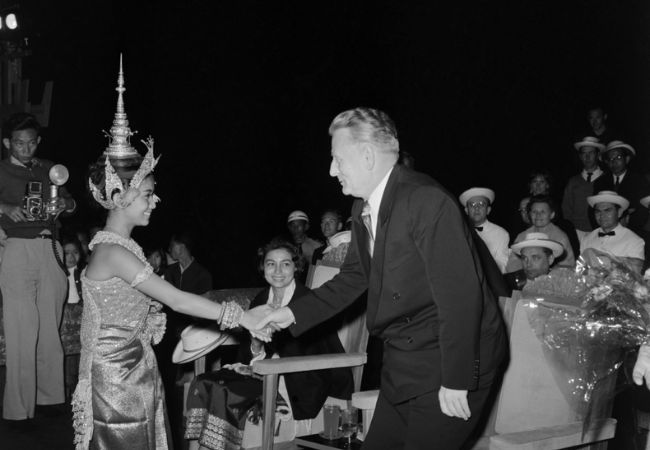
Princess Buppha Devi and Czech President Antonin Novotny shaking hands after a Royal Ballet performance in Prague, 1964
4. Khmer Apsara Dance today
Today, Khmer Apsara dance performances on modern stages have undergone simplification. The movements are more relaxed and liberal compared to traditional renditions, yet they still retain their characteristic essence.
In recognition of its cultural significance, UNESCO listed the Apsara dance as a Masterpiece of Oral and Intangible Heritage of Humanity in 2003. Presently, numerous restaurants and theaters across the country include Apsara dance performances as part of their evening entertainment, allowing audiences to experience and appreciate this treasured art form.
In recognition of its cultural significance, UNESCO listed the Apsara dance as a Masterpiece of Oral and Intangible Heritage of Humanity in 2003. Presently, numerous restaurants and theaters across the country include Apsara dance performances as part of their evening entertainment, allowing audiences to experience and appreciate this treasured art form.

Princess Buppha Devi and Proeung Chhieng from the Royal University of Fine Arts directing a rehearsal of the Royal Ballet at the Chaktomuk Theatre in 2017
III. Dancers and Movements
1. Costumes of dancers
The Apsara dance is not only characterized by its mesmerizing movements but also by the stunning and intricate costumes worn by the dancers, inspired by the bas-relief carvings of Angkor Wat. These costumes feature elaborate golden headdresses, flowing silk skirts, and a plethora of matching accessories including collars, armlets, bracelets, anklets, and earrings.
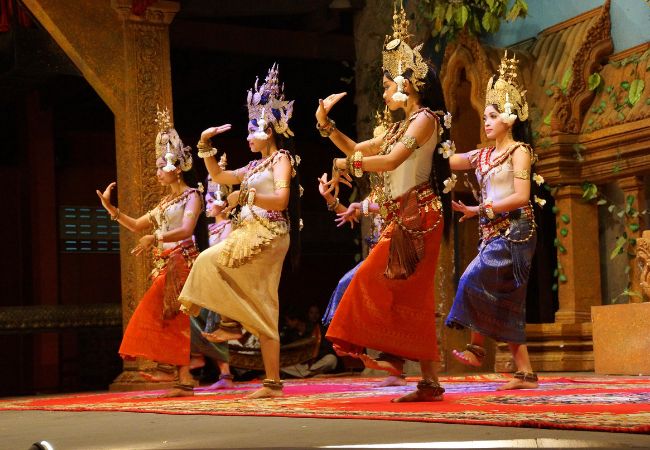
Apsara dancers wear traditional costumes when performing
Central to the costume is the sampot sarabap, a richly brocaded silk fabric with patterns woven from metallic threads. Traditionally imported from India and adorned with real gold or silver threads, the sampot sarabap is draped around the hips in a sarong-like fashion, with pleats at the front held in place by a decorative belt. The excess pleats create a fan shape at the front, known as the naga style, reminiscent of the winged head of the cobra or naga snake.
To imitate the bare-chested appearance of dancers from the Angkorian period, modern Apsara dancers wear tight-fitting silk bodices, often in a skin-like color. A round red or golden collar adorned with beaded designs and leaf-shaped ornaments is worn over the bodice, while some dancers also wear a decorative shawl-like garment called a sbai over their left shoulder.
To imitate the bare-chested appearance of dancers from the Angkorian period, modern Apsara dancers wear tight-fitting silk bodices, often in a skin-like color. A round red or golden collar adorned with beaded designs and leaf-shaped ornaments is worn over the bodice, while some dancers also wear a decorative shawl-like garment called a sbai over their left shoulder.

Dancers wear tight-fitting silk bodices to imitate ancient Angkorian's bare-chested appearance
The crown and hairdressing are also significant elements of the Apsara costume. Crowns, typically made of gold in the past, feature tall triangular forms with attached disks, varying in design based on the dancer's role. Real frangipani flowers adorn the dancer's long dark hair, complemented by a tassel of jasmine flowers and a red rose or frangipani flower tucked above the right ear.
Completing the ensemble are dangling earrings, armbands, bangles, and anklets, which elegantly slide and clink together during the performance, adding to the visual and auditory spectacle of the Apsara dance.
Completing the ensemble are dangling earrings, armbands, bangles, and anklets, which elegantly slide and clink together during the performance, adding to the visual and auditory spectacle of the Apsara dance.
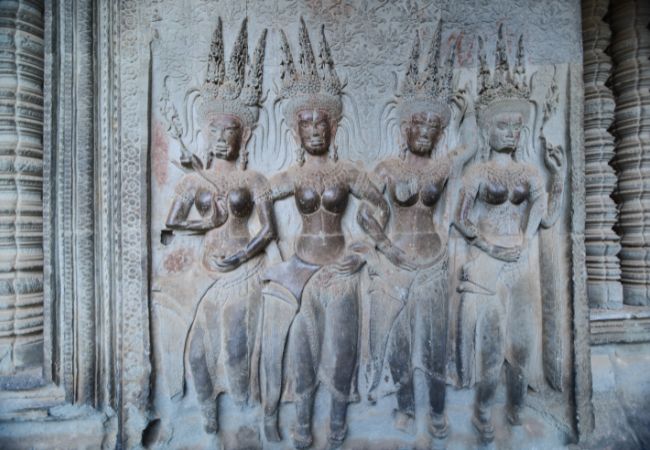
Carvings pedicting ancient Apsara dancer's performing costumes
2. Roles in Aspara dancing
Traditionally, the Apsara dance consists of four primary roles: the male, the female, the giant, and the monkey. While the male and female roles are typically portrayed by dancers of corresponding genders, the role of the monkey is usually played by a male dancer. Each role contributes to the narrative and visual richness of the performance, creating a dynamic and captivating experience for the audience.
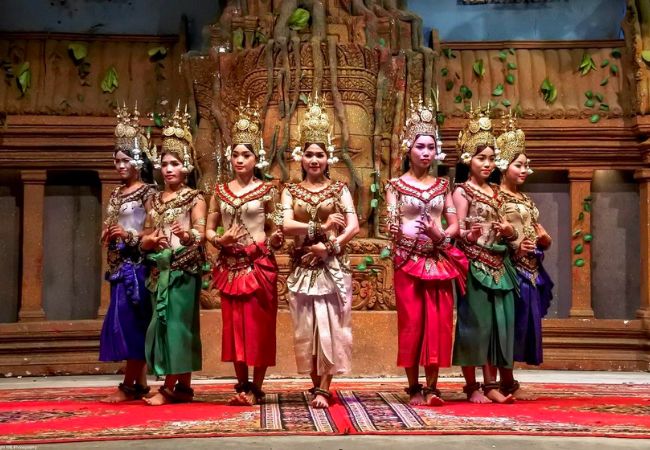
The Apsara dance are often performed in groups
3. Movements
Learning the Apsara dance is a rigorous endeavor that demands dedication and perseverance. Training typically begins before the age of 10 and can last up to 15 years. Contrary to traditional Western ballet, which primarily emphasizes leg and foot flexibility techniques, mastering this art form demands strength in the legs for intricate body movements and flexibility in the hands to execute elaborate gestures effortlessly, as if the extremities were devoid of bone joints.
Apsara dancers, akin to ethereal spirits, move with a slow yet graceful elegance, evoking heavenly goddesses gliding amongst the clouds. While often compared to "Cambodian Ballet," the Apsara dance transcends mere choreography, with each of its 1,500 sophisticated hand and finger gestures narrating the intricate history of Cambodia and expressing the soul of its people.
An Apsara dance performance typically features a main character accompanied by a group of dancers portraying fairies strolling through a rose garden. Unlike traditional dances from other cultures, Apsara requires slow and delicate movements to fully showcase the beauty of the dancer and the artistry of the dance itself.
In Apsara dance, each movement carries symbolic meaning, conveying various phenomena or characters. For instance, a curved finger pointing upwards signifies "today," while an arm placed at chest level represents "happiness." Intricate hand gestures such as depicting the image of the snake Naga or symbolizing life and death add depth and richness to the performance. Additionally, the flexibility and graceful foot postures of the dancers symbolize the cyclical nature of life.
Apsara dancing girls are expected to embody gracefulness and vitality, serving as spiritual symbols of the Khmer people. They must maintain a balanced physique through pointed exercises and demonstrate simplicity and gentleness in their movements during performances.
Apsara dancers, akin to ethereal spirits, move with a slow yet graceful elegance, evoking heavenly goddesses gliding amongst the clouds. While often compared to "Cambodian Ballet," the Apsara dance transcends mere choreography, with each of its 1,500 sophisticated hand and finger gestures narrating the intricate history of Cambodia and expressing the soul of its people.
An Apsara dance performance typically features a main character accompanied by a group of dancers portraying fairies strolling through a rose garden. Unlike traditional dances from other cultures, Apsara requires slow and delicate movements to fully showcase the beauty of the dancer and the artistry of the dance itself.
In Apsara dance, each movement carries symbolic meaning, conveying various phenomena or characters. For instance, a curved finger pointing upwards signifies "today," while an arm placed at chest level represents "happiness." Intricate hand gestures such as depicting the image of the snake Naga or symbolizing life and death add depth and richness to the performance. Additionally, the flexibility and graceful foot postures of the dancers symbolize the cyclical nature of life.
Apsara dancing girls are expected to embody gracefulness and vitality, serving as spiritual symbols of the Khmer people. They must maintain a balanced physique through pointed exercises and demonstrate simplicity and gentleness in their movements during performances.
IV. Top places to see
Apsara dance holds profound significance in Cambodia, revered as a cultural treasure and a reflection of the nation's soul. This traditional dance form embodies the Cambodian people's aspirations for a prosperous life and celebrates the beauty of nature. When visiting Cambodia, it's common to witness young women paying homage to Apsara bas-reliefs at temples by dancing, singing, and performing this ancient dance. Today, Apsara dancers play a vital role in showcasing Cambodian culture to tourists, with up to 300 performers entertaining audiences at restaurants, hotels, and theaters across the country.
In the capital city of Phnom Penh, visitors can experience the enchanting Apsara dance at the Chaktomuk Theater near the Royal Palace. Here, amidst bustling music and adorned in bright and charming costumes, audiences are treated to a captivating display of Cambodian artistry and tradition.
In the capital city of Phnom Penh, visitors can experience the enchanting Apsara dance at the Chaktomuk Theater near the Royal Palace. Here, amidst bustling music and adorned in bright and charming costumes, audiences are treated to a captivating display of Cambodian artistry and tradition.
1. Alliance Cafe
- Opening Hours: Tuesday, Thursday, Saturday – Dinner at 19:00, Show at 20:00
- Duration: 1 hour
- Location: Wat Damnak area
- Type: Shadow Puppet Theatre and Traditional Khmer Dance
- Note: No show during May & June
- Duration: 1 hour
- Location: Wat Damnak area
- Type: Shadow Puppet Theatre and Traditional Khmer Dance
- Note: No show during May & June
2. APSARA TERRACE
- April to October Wednesday, Friday, Sunday – Dinner at 19:00, Show at 19:45
- November to March: Daily – Dinner at 19:00, Show at 19:45
- Duration: 1 hour
- Location: Raffles Grand Hotel d’Angkor
- Type: Traditional Khmer Dance & Khmer Martial Arts
- November to March: Daily – Dinner at 19:00, Show at 19:45
- Duration: 1 hour
- Location: Raffles Grand Hotel d’Angkor
- Type: Traditional Khmer Dance & Khmer Martial Arts
3. Apsara Theatre
- Opening Hours: Everyday – Dinner at 19:30, Show at 20:30
- Duration: 1 hour
- Location: Off Wat Bo Road, opposite Angkor Village Hotel
- Type: Traditional Khmer Dance
- Duration: 1 hour
- Location: Off Wat Bo Road, opposite Angkor Village Hotel
- Type: Traditional Khmer Dance
4. La Noria Hotel
- Opening Hours: Wednesday & Sunday at 19:30
- Duration: 1 hour (1/2 hour Shadow Puppet & 1/2 hour Traditional Dance)
- Location: River Road, north of Highway No. 6
- Type: Shadow Puppet and Traditional Khmer Dance
- Note: Performances by children from the K.rousar Thmey NGO.
- Duration: 1 hour (1/2 hour Shadow Puppet & 1/2 hour Traditional Dance)
- Location: River Road, north of Highway No. 6
- Type: Shadow Puppet and Traditional Khmer Dance
- Note: Performances by children from the K.rousar Thmey NGO.
5. Temple Balcony
- Opening Hours: Every day at 19:30
- Duration: 2 hours
- Location: Pub Street
- Type: Traditional Khmer Dance
- Duration: 2 hours
- Location: Pub Street
- Type: Traditional Khmer Dance
6. The Divine Sala theater
- Location: 234 River Road, Siem Reap
- Description: The Sacred Dancers of Angkor, under the Patronage of HRH Princess Buppha Devi and the Support of UNESCO, perpetuate the artistic tradition with passion and dedication. Trained in the ancestral Khmer tradition, these young musicians and dancers are now professionals, mastering the silent language of the classical repertoires.
- Description: The Sacred Dancers of Angkor, under the Patronage of HRH Princess Buppha Devi and the Support of UNESCO, perpetuate the artistic tradition with passion and dedication. Trained in the ancestral Khmer tradition, these young musicians and dancers are now professionals, mastering the silent language of the classical repertoires.
V. Final words
The Cambodian Apsara dance stands as a testament to the country's rich cultural heritage and artistic prowess. With its graceful movements, intricate gestures, and vibrant costumes, the Apsara dance captivates audiences worldwide, offering a glimpse into Cambodia's soul and traditions.
Spend your summer immersed in the rich culture and arts in the “Land of the Khmer” and let Aurora Travel guide you on an unforgettable adventure.
For more information on Cambodia tours, visit our website here.
Spend your summer immersed in the rich culture and arts in the “Land of the Khmer” and let Aurora Travel guide you on an unforgettable adventure.
For more information on Cambodia tours, visit our website here.

